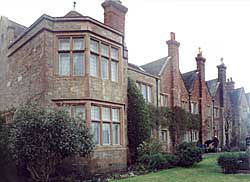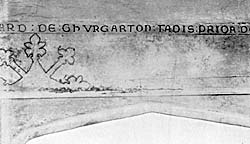Felley Priory
By The Rev A M Y Baylay

The 17th century gables of the west front of Felley Priory. Very little medieval fabric survives in the existing buildings at Felley. (© Andrew Nicholson, 2003).
The Priory of St. Mary of Felley was founded about the middle of the 12th century by Ralph Brito, who was lord of Annesley. There was already on the spot some sort of a chapel of our Lady, served by a hermit, and this chapel had itself received certain endowments from Ralph, who devoted them to God, Blessed Mary, St. Helen, and to Robert the hermit and his successors, also placing the chapel and hermitage under the patronage and control of the prior and canons of Radford in Worksop. This endowment seems to have been made in 1151, but in 1156 Ralph replaced the hermitage by a small house of canons regular of St. Austin The canons were imported from Worksop, to which house the Priory of Felley was to be subordinate as a “cell.” The foundation was confirmed by Reginald de Annesley, son to Ralph, and by Pope Alexander III., in 1161. There was a further confirmation of its rights and possessions, by Pope Celestine III. (1194), who permitted to the canons of Felley the saying of mass in a low voice, without ringing of bells, and with closed doors, even during a general interdict, and also gave them the right of sepulture for such persons external to their community,— not being excommunicate,—as should devoutly desire it. We learn, from the terms of the foundation of a chantry by Geoffrey Barry, that there was in the conventual church of Felley an altar of St. Edmund of Pontigny, Archbishop of Canterbury, canonized in 1248.
In 1260 the Priory of Felley achieved its independence of Worksop, the prior and canons of the hatter being willing,—apparently for the sake of peace and quietness,—to relinquish their control, on condition of the annual payment of 10s., which they had hitherto claimed from FeIley, being replaced by one of twice that amount. This agreement was made, by consent of Godfrey de Ludham, Archbishop of York, between John, prior of Worksop, and Henry, prior of Felley.
In the 13th century they had troubled times at Felley. Ralph of Pleasley, prior, was deposed for sundry misdemeanours in 1276, by sentence of Archbishop Walter Giffard, who at the same time had also to punish two other of the canons for their misconduct, Richard of Codnor and Robert Barry. The latter had, it seems, some ten years previously, been readmitted to the house of Pelley, by sentence of the same archbishop, after having deserted it! The canons elected Thomas of Wathenowe as prior in the room of Ralph.

The east front of Felley Priory (© Andrew Nicholson, 2003).
The priory received a considerable number of benefactions at various dates. One of the earliest was the advowson and tithes of the church of Annesley. This, originally given by the founder, and confirmed by his son Reginald, was again confirmed to the priory by Leonia de Raines and Henry de Stutevill her son. This deed was promoted by Archbishop Godfrey in order to put an end to the controversies about the patronage of Annesley church, which had arisen between Leonia, the lord of Annesley, and the rector of Kirkby-in-Ashfield.The priory possessed also the tithes of the church of Attenborough. Originally they had only a mediety of these, granted to them in 1339, and confirmed in 1343, but eventually they seem to have acquired the whole, subject to an annual payment of £6 13s. 4d. to the Priory of Lenton, in lieu of the other mediety, which had been appropriated to that house.The family of De Heriz were large benefactors. Among their other gifts, eighteen bovates of land at Tibshelf were specially given for the maintenance of two additional canons at Felley. Certain lands at Dethick, given by the family of that name, were charged with the maintenance by the Canons of Felley of a chaplain to serve the chapel of Dethick. Another benefaction among those held by the priory was charged with the payment of a stipend for a priest to serve a chantry at the altar of our Lady in the church of Mansfield Woodhouse. Very full details as to the various possessions of this priory will be found in the article on Felley in the Victoria County History for Notts. The gross annual value at the Dissolution was £61 4s. 8d, and the net income £40 19s. 1d.
In 1311, the canons, being anxious to make manifest their title to their possessions, obtained leave from Archbishop William Greenfield to make public exhibition of their title deeds, which they accordingly did, at St. Mary’s Church, Nottingham, on the day after Ascension Day in that year.
The following is a list of all the priors of Felley, so far as known
Walter (1156).
Adam of Nocton (reign of Henry II).
William de Lovetot (reign of Henry II.)
Henry (reign of Henry III.).
Thomas (reign of Henry III.).
Walter (his name occurs about 1240).
Henry (prior at the time when Felley was made independent of Worksop).
Ralph of Pleasley (1268: deposed in 1276).
Thomas of Wathenowe (1276).
Alan of Elksley (1281).
William of Toton (resigned in 1315).
Elias of Linby (1315).
Adam.John of Kirkby (1328).
John of Holbrook (1349).
Richard of Shirebrook (1349).
Robert Eaves (died 1378).
Thomas Elmton (1378).
John of Mansfield (1381).
William Tuxford (died 1405).
William Hopwood (1405).
Peter Methley (1442).
John Throughcroft (died 1454).
William Acworth (1454: He became Prior of Worksop in 1463).
Richard Congreve (1463).
William Symondson, alias Bolton (1482).
Laurence Ingham (1500).
Robert (or Thomas) Gateford. (He became Prior of Worksop in 1518).
Thomas Stock (1519).
Christopher Bolton—the last prior.
The priory was dissolved in 1536, along with the other smaller religious houses, the prior and canons receiving pensions. The prior’s pension, however, ceased on July 2nd, 1537, on his accepting the benefice of Attenborough.
The church of Annesley had been served by the canons of Felley, neither rector nor vicar being appointed. At the Dissolution the rectory of Annesley was granted to Richard Samond, and the priory of Felley to William Bolles and Lucy his wife. This Bolles had been one of Thomas Crumwell’s commissioners, and “receivers” of the property of the despoiled religious houses. Like others of his class, he did not fail to enrich himself out of the plunder. He claimed descent from the ancient family of Bolle, or Bolles, of Haugh, on the Lincolnshire South Wold. But his father, William Bolles, of Wortham in Suffolk, did not bear the same arms as Bolle of Haugh. He does not seem to have remained long at Felley, having purchased from one of his fellow-commissioners, Robert Deighton, an estate at Osberton, and removed thither. Apparently he sold Felley, for in the reign of Philip and Mary, we find it in the possession of Anthony Strelley and Joan his wife. By the time of James I., it had become the property of the family of Millington, who long possessed it.
But few remains of the monastic buildings have survived. A fine Norman arch, part of the original fabric, was standing until modern times,—being apparently the chancel arch of the church,—but it was destroyed a good many years ago, though its two responds (moved from their original position) are still entire, and fragments of the arch itself are lying about. The community was never numerous, and the church probably only consists of a nave and chancel, as was the case with sundry other churches of small outlying priories of this order, not founded in parish churches. The head of a lancet window, which has been wrongly supposed to be the arch of a piscina, bears witness to work carried out in the 13th century, as does also a wall in the garden on the south of the priory, running east and west, which may possibly have been one side of the refectory, or may have formed part of the buildings of the infirmary. The existing dwelling-house almost certainly stands on the site of the buildings ranging along the west side of the cloister, and a good 15th century doorway in its west front is very probably in its original position, as is the case also with some buttresses, and a considerable portion of the lower part of the wall of this front. But the house itself has, as a whole, been rebuilt since the dissolution of the priory, and the cloisters, with the other buildings surrounding them, have vanished.
On the west front of the house are two much mutilated stone carvings of a heraldic character, locally believed to represent the lion and unicorn I Some ancient chimney-stacks are ornamented with curious little lead figures representing a stag’s head, collared. One concludes that this must be the crest of one or other of the families who possessed Felley after the Dissolution, but I am sorry to say I have not been able to ascertain anything more about the matter. It is not the crest assigned to Bohle (of Haugh), nor that of the family of Strelley.

The memorial stone for Richard de Thurgarton, Felley Priory.
Within the house, one most interesting feature is to be noted. A large gravestone has been removed from the floor of the church or cloister, and sawn in two lengthwise to form a chimney piece over a fireplace in one of the rooms. One half of the incised cross, of elaborate design, is plainly to be seen on it, and the following portion of the inscription, in Lombardic capitals :—
- - - CHARD DE THURGARTON – IADIS – PRIOR DE CES (te Eglise)
The name no doubt was Richard. No Richard of Thurgarton appears among the recorded names of priors of Felley. But the date of this stone, from the style of the cross and lettering, appears to be in the 13th century, and this Richard may well have been prior at some time before Felley was made independent of Worksop in 1260, the list of priors previous to that date being obviously incomplete. It is probable enough that lie had been a canon of the sister house of Thurgarton, before his promotion to be prior of Felley.
